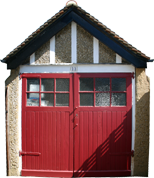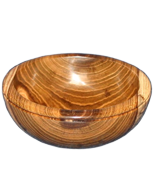Making a Chainsaw Horse.
Why Use a Chainsaw?
If you always purchase your turning blanks ready
prepared or simply use purchased wooden boards
seasoned and already cut to size, then you probably
don't need a chainsaw. If, on the other hand, you
obtain unseasoned timber from tree surgeons or obtain
un-cut green timber from other sources then you will
almost certainly need a chainsaw to cut the timber
into manageable sizes which are then small enough for
further more accurate trimming using a bandsaw or
tablesaw. The maximum cutting depth of my
Record Power BS300 bandsaw is 190mm
(about 7½ inches), so a chainsaw is essential
for cutting larger stock.
Petrol or Electric chainsaw?
Traditionally chainsaws have always been petrol
powered but now there are a growing number of good
electrically powered (and even battery powered)
models on the market. If the intention is to use the
saw wholly for trimming timber and NOT for
serious tree felling, then in my view the electric
saws are by far the best option. They are quieter,
and no smelly & messy petrol to deal with. For
your own safety, do buy a good quality model
manufactured by a recognised chainsaw manufacturer
such as Alko, Bosch, Makita, Oregon, Ryobi
or Stihl to name a few. There are some
chainsaws for sale which are cheap & cheerful but
also potentially lethal due to poor construction.
Try Before you Buy?
After acquiring a large cherry log from a tree
surgeon felling a tree on our estate, I decided that
I would need to use a chainsaw to prepare some
turning blanks from it. I hired a Bosch
electric chainsaw from a local tool hire company
(sensibly they would not hire a petrol chainsaw to a
novice). This enabled me to process the Cherry. The
cost of hiring for a day was almost as much as
purchasing a new electric chainsaw and, having
realised how essential a chainsaw is in converting
green timber, I decided to purchase one. As I was
very pleased with the performance of the
Bosch machine and it was also
recommended by members of my woodturning club, I
decided to purchase the same model which was a
Bosch AKE 40-19 S.
More on Electric Chainsaws.
Electric chainsaws are not as powerful as their
petrol driven relatives. 2,400 watts is about the
maximum which can be safely powered from a domestic
mains supply plug and socket. The maximum cutting
length of the guide bar is usually about 40cm (16
inches). A few of the most powerful electric saws
come with a 45cm (18 inch) guide bar. These electric
saws are aimed at the home/occasional user market and
are not designed for commercial or intensive tree
felling work. The chains are smaller and thinner,
driven by sprockets with 6-7 teeth, thereby
maximising the torque delivered by the electric
motor.
My Bosch AKE 40-19 S Electric Chainsaw
(purchased in September 2009), is rated at 1900 Watt,
has a bar (cutting) length of 40 cm. The gauge of the
chain is the width of the drive links, and is
dictated by the gauge of the bar on which it is to be
run. Usual gauges for electric chainsaws are 0.043"
(1.1mm) to 0.050" (1.3 mm). Chain and bar gauge must
match; a chain that is too large will not fit, one
that is too small will fall sideways and cut poorly.
Pitch The pitch of the chain is the average distance
between two rivets. As the distance between rivets
varies, the pitch can be measured by measuring
between three rivets and dividing this distance by
two. Typical pitches are 0.325", ⅜" (0.375)
and 0.404". ¾" is used for harvester
applications, and very rarely for handheld cutting.
The pitch of the chain must match the drive sprocket,
and the nose sprocket (if fitted). Sprocket and rim
can be in one unit or separated. Length A chain loop
must be of an appropriate length in order to run
safely. This is described by the number of drive
links. This number is determined by the length and
type of bar, the sprocket size and the overall
configuration of the saw. For replacement purposes,
simply count the drive links on the old chain. Life
time of a chain The teeth of a chain come with a
certain length. Wear and sharpening cause the teeth
to become shorter. End-of-life is reached when the
top of the head is too short. Interval between
sharpenings A saw chain must be sharpened when the
saw starts to vibrate or poorly cuts. The operator
can easily feel the vibrations in the handles and the
engine runs harder while cutting. Identification of
the chain The length, gauge and number of drive links
is punched on the side of the saw bar. This
information can be found near the saw head. Since the
saw bar should be turned 180 degrees between
sharpenings, the punched information can be towards
the saw power head or outside. Identification of a
suitable chain Consult the saw's manual to determine
which chain/bar combinations are compatible with the
saw. A given saw will usually accept a number of
different bars and chains. Specialised chains
Essential additional equipment
Chainsaw Horse
This saw horse is fairly compact but can handle
moderately large tree trunk sections and irregularly
shaped pieces of timber. The design is not mine but
by Richard Stapley and originally appeared
several years ago on his Laymar Crafts website before
subsequent removal when that site was re-designed a
few years ago.
![[Construction drawing of chainsaw horse, side view - click for larger view] Construction drawing of chainsaw horse, side view.](images/chainsaw-platform-side-viewthmb.jpg)
|
Chainsaw Horse Plan (Side View).
The horse is simply constructed from 18mm thick
MDF (Medium-density fibreboard) panels, held
together with 24 nuts on two M12 mm threaded
rods protected with 10 sleeves/spacers of 40mm
diameter 2mm thick sections of plastic
polypropylene waste pipe. See the full size
drawings for the dimensions.
(Click picture for larger view)
|
![[Construction drawing of chainsaw horse, end view - click for larger view] Construction drawing of chainsaw horse, end view.](images/chainsaw-platform-end-viewthmb.jpg)
|
Chainsaw Horse Plan (End View).
Shows the dimensions of the six 18mm thick mdf
(medium-density fibreboard) panels.
(Click picture for larger view)
|
![[Construction drawing of chainsaw horse - click for larger view] Construction drawing of chainsaw horse.](images/project-05a-detailsthmb.jpg)
|
3D-drawing of the Chainsaw Horse (WITHOUT the
plastic pipe rod sheathing).
This interactive Sketchup 3D-drawing, of
the chainsaw horse is without the plastic waste
pipes to show how the mdf panels are held in
position on the two M12 threaded rods with a
series of nuts & washers.
(Click picture to view the interactive drawing)
The Flash application is required to
view this drawing.
|
![[Construction drawing of chainsaw horse - click for larger view] Construction drawing of chainsaw horse.](images/project-05b-detailsthmb.jpg)
|
3D-drawing of the Chainsaw Horse (INCLUDING
the plastic pipe rod sheathing).
This interactive Sketchup 3D-drawing, of
the saw horse shows how the metal rods are
protected from accidental contact with the
chainsaw blade by using 40mm diameter plastic
waste pipe sections.
(Click picture to view the interactive drawing)
The Flash application is required to
view this drawing.
|
![[Chainsaw Horse as constructed - click for larger view] Chainsaw Horse as constructed.](images/img_3807crthmb.jpg)
|
Chainsaw Horse as constructed.
The horse after construction, ready for use.
(Click picture for larger view)
|
Click HERE to return to the Home
Page.
© Tim & Trish Enterprises 2015-2017.


![[Construction drawing of chainsaw horse, side view - click for larger view] Construction drawing of chainsaw horse, side view.](images/chainsaw-platform-side-viewthmb.jpg)
![[Construction drawing of chainsaw horse, end view - click for larger view] Construction drawing of chainsaw horse, end view.](images/chainsaw-platform-end-viewthmb.jpg)
![[Construction drawing of chainsaw horse - click for larger view] Construction drawing of chainsaw horse.](images/project-05a-detailsthmb.jpg)
![[Construction drawing of chainsaw horse - click for larger view] Construction drawing of chainsaw horse.](images/project-05b-detailsthmb.jpg)
![[Chainsaw Horse as constructed - click for larger view] Chainsaw Horse as constructed.](images/img_3807crthmb.jpg)